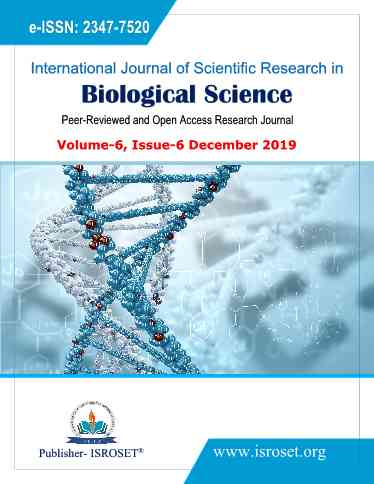Epidemiology of Bipolar Disorder
Keywords:
Bipolar Disorder, Schizophrenia, Depression, ManiaAbstract
Bipolar disorder (BD) is a complex psychiatric mood disorder associated with swinging episodes of mania and depression. Lifetime prevalence of BD is 1% and bipolar spectrum disorder is 2.4%. BD is associated with high rate of premature mortality. Suicidal deaths are familiar in BD compared to general population. Early recognition helps in better treatment of the disorder so as to protect the individual from suicidal thoughts and also from socioeconomic burden.In the present study, epidemiological data was collected from Government Hospital for Mental Care, Visakhapatnam. Most of the patients who attended the hospital belonged to coastal districts of Andhra Pradesh. Of all the mental disorders diagnosed in the hospital, during the period January, 2014 to December, 2018, schizophrenia ranks first with highest number of cases. Regarding BD, more number of males were affected when compared to females. Highest prevalence was observed in 21 -30 years age group. Mania was the most common episode in both the sexes compared to depression.
References
Craddock & L. Forty, “Genetics of affective (mood) disorders”, European Journal of Human Genetics, Vol. 14, issue.6, pp. 660-668, 2006.
World Health Organization, World Mental Health Survey Consortium: prevalence, severity and unmet need for treatment of mental disorders in WHO world mental health surveys. JAMA, June 2, 291(21), pp 2581–90, 2004.
Ronald C. Kessler, Patricia Berglund, Olga Demler, Robert Jin, MA; Kathleen R. Merikangas, Ellen E. Walters ,”Lifetime Prevalence and Age-of-Onset Distributions of DSM-IV Disorders in the National Comorbidity Survey Replication”, Arch Gen Psychiatry, Vol.62, pp. 593-602, June 2005.
G Gururaj, N Girish , M.K. Isaac , “ Mental, Neurological and substance abuse disorders: Strategies towards a systems approach, Burden of Disease in India, NCMH Background Papers,September 2005.
L. Fajutrao, J. Locklear, J. Priaulx, & A. Heyes, “A systematic review of the evidence of the burden of bipolar disorder in Europe” , Clinical Practice and Epidemiology in Mental Health,Vol. 5, issue.3, 2009.
K. R Merikangas, R.Jin, J. P.He, R. C. Kessler, S.Lee, N. A.Sampson, Z. Zarkov, “Prevalence and correlates of bipolar spectrum disorder in the world mental health survey initiative”. Arch Gen Psychiatry, Vol. 68, issue.3, pp. 241-251, 2011.
J. Angst, “The emerging epidemiology of hypomania and bipolar II disorder”, Journal of Affective Disorders, Vol.50, issue. 2-3, pp. 143-151, 1998.
P. Bebbington & R Ramana, “The epidemiology of bipolar affective disorder”, Social psychiatry and psychiatric epidemiology, Vol.30, issue.6, pp. 279-292.1995.
B. F. Grant, F. S Stinson, D. S Hasin, D. A Dawson, S. P Chou, W. J Ruan, & B Huang, “Prevalence, correlates, and comorbidity of bipolar I disorder and axis I and II disorders: results from the National Epidemiologic Survey on Alcohol and Related Conditions”, Journal of Clinical Psychiatry, Vol. 66, issue.10, pp. 1205-1215, 2005.
J. H. Gold, “Gender differences in psychiatric illness and treatments: a critical review”, The Journal of Nervous & Mental Disease, Vol. 186, issue.12, pp.769-775. 1998.
W Maier, B.Hofgen, A. Zobel, & M. Rietschel, “Genetic models of schizophrenia and bipolar disorder: overlapping inheritance or discrete genotypes?” European Archives of Psychiatry and Clinical Neuroscience, Vol. 255, issue.3, pp. 159-166, 2005.
S Parial,” Bipolar disorder in women”, Indian journal of psychiatry, Vol.57,Suppl. 2, pp. S252-S263, 2015.
R. S. Murthy, “National Mental Health Survey of India 2015-2016 “ Indian journal of psychiatry, Vol.59, issue.1, pp. 21-26, 2017.
C. J. Murray, & A. D. Lopez, “Global mortality, disability, and the contribution of risk factors: Global Burden of Disease Study”, Lancet, Vol. 349, issue. 9063, pp.1436-1442, 1997.
R.M. Hirschfeld, &, L. A Vornik, “Bipolar disorder--costs and comorbidity”. The American Journal of Managed Care, Vol.11, Suppl.3, pp. S85-90, 2005.
B Roshanaei-Moghaddam, W Katon, “Premature mortality from general medical illnesses among persons with bipolar disorder: a review”, Psychiatr Services, Vol. 60, No.2: pp. 147-156, 2009.
C. Crump, K. Sundquist, M. A. Winkleby & J. Sundquist, “Comorbidities and mortality in bipolar disorder: a Swedish national cohort study”, JAMA Psychiatry, Vol.70, issue.9, pp. 931-939, 2013.
R.M. Hirschfeld , JR Calabrese , MM Weissman, M. Reed, MA. Davies , MA. Frye , PE. Keck Jr, L. Lewis , SL.McElroy , JP McNulty, KD Wagner, “Screening for bipolar disorder in the community.Journal of Clinical Psychiatry”, Jan vol.64, issue.1, pp. 53-59,2003.
J. C .Robb, L. T.Young, R. G. Cooke, & R. T. Joffe, “Gender differences in patients with bipolar disorder influence outcome in the medical outcomes survey (SF-20) subscale scores.” Journal of Affective Disorders, Vol.49, issue. 3, pp. 189-193,1998.
I. Kawa, J. D.Carter, P. R., Joyce, C. J.Doughty, C. M.Frampton, J. E .Wells, R. J Olds, “Gender differences in bipolar disorder: age of onset, course, comorbidity, and symptom presentation”, Bipolar Disorder,Vol. 7,issue.2, pp.119-125, 2005.
A. Diflorio, I. Jones, “Is sex important? Gender differences in bipolar disorder”,International Review of Psychiatry, vol.22, issue.5, pp. 437-52, 2010.
L. Miguel ,C. Roncero , C López-Ortiz , M Casas, “Epidemiological and diagnostic axis I gender differences in dual diagnosis patients” Adicciones Vol.23, issue.2, pp.165-172, 2011.
Saioa López-Zurbano & Ana González-Pinto,“Gender Differences in Bipolar Disorder, ,Psychopathology in women, Springer International Publishing Switzerland, September, pp 641-659, 2015.
Trisha Suppes,” Gender Differences in Bipolar Disorder, CNS Spectrums’’, Volume 11, Issue S5, pp. 2-4, May,2006.
Downloads
Published
How to Cite
Issue
Section
License

This work is licensed under a Creative Commons Attribution 4.0 International License.
Authors contributing to this journal agree to publish their articles under the Creative Commons Attribution 4.0 International License, allowing third parties to share their work (copy, distribute, transmit) and to adapt it, under the condition that the authors are given credit and that in the event of reuse or distribution, the terms of this license are made clear.







